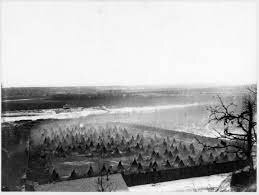There's More to Pike Island
I have lived in Minnesota for almost twenty years and I had NEVER heard of Pike Island. I doubt that many Minnesotans have. Does it matter? I think it does.
Pike Island is very small - about 1.3 miles long and .25 mile wide - but it has seen a lot of history. Before the era of westward expansion, the island was central to the many native american tribes who hunted, traded, and formed alliances around the Great Lakes. Situated at the spot where the Mississippi River merges with the Minnesota River, the eastern tip of land is known as Bdote: “where two waters come together”.
To the Mdewakanton Dakota, this Bdote is the center of their universe. It is where they descended from the stars and where their history began.
A Different Pike’s Place
In 1803, the United States completed the Louisiana Purchase. Just because the United States had purchased the vast expanse from France didn’t mean that the Ojibwe, Ho-Chunk and Dakota who inhabited it were ready to give it up. There were also French fur traders and British troops operating throughout the west who needed to be informed of the new status and brought in line. President Thomas Jefferson tasked Lt. Zebulon Pike with mapping out the northern reaches of the Mississippi River and securing it for the expanding nation.
By 1805, Lt. Pike had arrived at the confluence of rivers and on the banks negotiated “Pike’s Purchase” or the Treaty of St. Peter’s. (Before Minnesota existed, the Minnesota river was known as St. Peter’s).
The treaty earned Pike an island named after him. Though he also has a bay, creek, and reservoir named for him in Minnesota, he didn’t put down roots near any of his tributes. He continued his journey westward and soon would also be the namesake of Pike’s Peak in Colorado.
A Bad Deal from the Start
The treaty stated that the Dakota would cede 100,000 acres of land in return for money. Pike had estimated the land value at $200,000, but congress disagreed and only paid $2,000. The 100,000 acres were never mapped or specified. Most of the Dakota at the treaty signing couldn’t read english. In addition, the treaty was never proclaimed by the President, which is a crucial step in making it official. But the government moved forward undeterred and by 1825, Fort Snelling was completed on the bluffs overlooking Pike Island.
Over the next fifty years, there would be much back and forth between the government and the native americans leading to bitterness, distrust and hardship.
From Bad to Worse
By 1861, the Dakota were at a breaking point. Overhunting in the territory by settlers had made game scarce. A bad season of farming left many without enough supplies to make it through the winter. Discrimination and corruption by the government agents angered native americans and was so blatant that white settlers began writing to the government warning that a storm was on the horizon.
In August of 1862, the situation exploded when four Dakota men killed five white settlers at Acton Township, Meeker County (about 90 miles west of the Twin Cities today). When reports got back to tribal leaders they knew there was no going back. Whether in fear of what punishment awaited them or because of the painful treatment they were receiving, the Dakota chose to go to war.
As the battles began raging across the state, officials forced more than 1,600 Dakota elders, women and children into an internment camp on Pike Island. Living in close quarters, without resources or medical care, 130 to 300 of them died throughout the winter. The survivors were forced to leave the state after the war ended and sent to reservations in South Dakota and Nebraska.
After rushed trials where the accused had no legal representation, 38 Dakota men were sentenced to death and on December 26, 1862 they were publicly hanged in Mankato, Minnesota. The Dakota Uprising or U.S.-Dakota War of 1862 would result in the deaths of approximately 600 white settlers and 100 Dakota.
No Happy Ending
After the hangings, attention quickly shifted to the Civil War beginning in the south. Fort Snelling became a recruiting and training center for new soldiers and Pike Island continued to be farmed by immigrant families establishing a foothold in the new state capital, St. Paul. By 1950, the Fort was no longer in use and was scheduled to be demolished to make way for a new highway. Instead, a tunnel was created under the fort and a state park was formed to preserve the area.
Today, Pike Island is a part of Fort Snelling State Park. It sits in the shadow of MSP Airport, a busy I-94 interchange, and under the Mendota Bridge. It’s a practically forgotten piece of land that can only be reached by a footbridge and no bicycles are allowed. We can enjoy the island anytime we want and can appreciate it even more by remembering its past and who was here before us.
PIN TO READ LATER
Hello, World!















